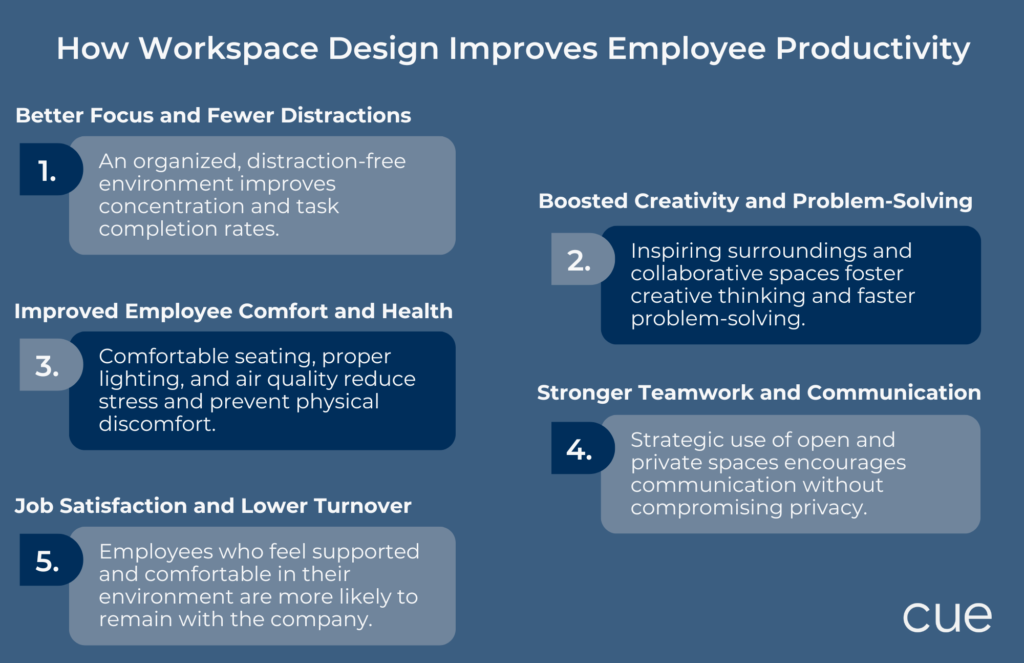Creating a workspace that helps employees feel comfortable, focused, and motivated isn’t just about looks but results. When employees are uncomfortable or distracted, their productivity drops, creativity suffers, and turnover increases. Business owners who overlook workspace design often face higher costs and disengaged teams.
A well-designed workspace, on the other hand, drives better performance and job satisfaction. From ergonomic furniture to thoughtful layouts, strategic design choices create an environment where employees can thrive. Co-working spaces have emerged as a practical solution, offering flexible, professional environments without the high costs and long-term commitments.
In this article, we’ll explore how smart workspace design boosts employee productivity and why co-working spaces are becoming a strategic choice for modern businesses.
Table of Contents
Why Employee-Focused Workspace Design Matters
Workspace design isn’t just about aesthetics. It shapes how employees feel, interact, and perform. A poorly designed workspace can lead to disengagement, physical discomfort, and decreased efficiency. Conversely, a thoughtfully designed environment enhances focus, encourages collaboration, and supports overall well-being.
For business owners, a poorly designed workspace results in:
- Higher turnover: Uncomfortable or uninspiring workspaces push employees to seek better opportunities.
- Decreased productivity: Poor lighting, noise, and discomfort reduce employee focus and efficiency.
- Increased operational costs: Inefficient layouts lead to wasted space and higher utility and maintenance costs.
- Difficulty attracting top talent: Modern workers value comfort, flexibility, and wellness in the workplace.
Co-working spaces provide a practical solution to many of these challenges. They offer well-designed, adaptable spaces with ergonomic furniture, high-speed internet, and shared amenities, allowing businesses to focus on growth while providing employees with a comfortable and productive environment.

Core Principles of Effective Employee-Focused Workspace Design
1. Functional Space Allocation
Effective workspace design starts with understanding how different teams and roles operate. Different types of work require different settings: some employees need quiet, focused areas, while others thrive in collaborative environments. For business owners, poor space allocation can lead to underutilized areas, noise disruptions, and disengaged employees.
Implementation Strategies:
- Designate zones for different work styles: Create dedicated spaces for deep work, open collaboration, and informal meetings. For example, you can position quiet rooms or pods away from high-traffic areas while setting up open workstations for collaborative teams.
- Incorporate movable partitions and furniture: Use lightweight partitions or rolling whiteboards to give employees flexibility in shaping their workspaces based on immediate needs. This allows business owners to adapt the workspace as team structures or work requirements change.
- Create multi-functional spaces: Meeting rooms can double as quiet zones when not in use. Design furniture that’s easy to move and reconfigure to make the most of available space.
- Balance privacy and openness: Use glass partitions instead of solid walls to maintain a sense of openness while offering privacy. This fosters a collaborative culture while giving employees the option to focus.
- Leverage co-working spaces for overflow: If your office lacks space or flexibility, co-working spaces offer an effective alternative. They provide ready-to-use workspaces with built-in zones for quiet work, collaboration, and relaxation.

2. Ergonomic and Adjustable Furniture
Poor posture and discomfort from ill-fitting desks and chairs lead to decreased focus and increased health issues. For business owners, this translates into higher absenteeism, lower morale, and increased healthcare costs.
Implementation Strategies:
- Provide height-adjustable desks: Sit-stand desks allow employees to switch between sitting and standing positions, which promotes better circulation and reduces back strain.
- Invest in ergonomic chairs: Ensure that chairs offer lumbar support, adjustable armrests, and seat depth to accommodate different body types. This reduces long-term physical strain and improves employee comfort.
- Provide ergonomic accessories: Offer wrist supports for keyboards, footrests, and monitor stands to help employees maintain a neutral posture.
- Encourage movement: Install standing desks or walking tracks to encourage physical activity during the workday.
- Use co-working spaces with ergonomic options: Many co-working spaces are already equipped with ergonomic furniture, which can be a cost-effective way to improve employee comfort without major capital investment.
3. Lighting Optimization
Poor lighting causes headaches, eye strain, and fatigue, which lowers productivity and increases absenteeism. Business owners often overlook lighting as a cost-saving measure, but this can negatively impact employee performance and morale.
Studies show that employees with access to natural light reported a 63% reduction in headaches and eye strain, highlighting the importance of well-lit workspaces for both comfort and efficiency.
Implementation Strategies:
- Maximize natural light: Position desks and workstations near windows to allow natural light exposure, which has been linked to improved mood and concentration.
- Use layered lighting: Combine overhead lighting, task lighting, and ambient lighting to create a balanced and adaptable environment.
- Leverage smart lighting systems: Daylight sensors and occupancy sensors help regulate lighting, reduce energy costs, and enhance comfort.
- Light temperature control: Warm lighting promotes relaxation, while cooler lighting enhances focus and attention to detail.
- Co-working spaces often include optimized lighting: Using a co-working space allows businesses to benefit from professional-grade lighting setups without additional investment.
4. Sound Control and Acoustics
Noise pollution is one of the biggest disruptors of employee focus. Open-plan offices, while great for collaboration, often increase noise levels, leading to stress and lower productivity.
Implementation Strategies:
- Introduce soundproofing materials: Acoustic panels, ceiling tiles, and carpeting help absorb sound and reduce echo.
- Create quiet zones: Establish separate areas for focused work.
- Provide noise-canceling headphones: Offering employees noise-canceling options helps them manage distractions.
- Co-working spaces often provide sound-controlled options: Many co-working spaces feature designated quiet areas or soundproof meeting rooms.
5. Temperature and Air Quality Control
When office temperatures are inconsistent or the air feels stale, employees struggle to stay focused and energized. Poor air quality increases fatigue and illness, driving up absenteeism. In fact, studies have found that improving air quality can boost employee cognitive function by 61%. Keeping the workspace well-ventilated and maintaining comfortable temperatures creates a healthier environment where employees can perform at their best.
Implementation Strategies:
- Smart climate control: Use smart thermostats to maintain consistent temperatures across different work zones.
- Improve ventilation: Install HEPA filters and upgrade HVAC systems to ensure clean airflow.
- Introduce biophilic design: Plants improve air quality, reduce toxins, and create a calming atmosphere.
- Zone-based temperature control: Allow different areas of the office to maintain different temperatures based on employee needs.
6. Office Layout and Traffic Flow
How employees move within a workspace affects efficiency and collaboration. Poorly designed layouts lead to unnecessary movement, congestion, and bottlenecks.
Implementation Strategies:
- Minimize obstructions: Keep walkways clear and place furniture in a way that allows easy navigation.
- Design wide walkways: Wider hallways prevent bottlenecks during peak hours.
- Position shared resources strategically: Place printers, coffee machines, and other communal equipment in central locations to minimize movement time.
- Separate high-traffic areas from workspaces: Keep entryways, elevators, and common areas separate from quiet work zones.
7. Technology Integration and Infrastructure
Outdated or unreliable technology disrupts workflow and creates frustration, leading to lost productivity and increased IT support costs.
Implementation Strategies:
- Provide high-speed internet and Wi-Fi: Ensure strong, consistent internet connectivity throughout the office.
- Smart meeting rooms: Install video conferencing, wireless screen sharing, and remote collaboration tools.
- Cloud-based storage: Use cloud platforms for seamless file sharing and collaboration.
- Cybersecurity: Protect company data with firewalls, encryption, and multi-factor authentication.
8. Break and Wellness Areas
Continuous work without proper breaks leads to mental exhaustion and reduced output. Providing spaces where employees can relax and recharge improves overall engagement.
Implementation Strategies:
- Create comfortable lounges: Provide soft seating and relaxed lighting to create a calming atmosphere.
- Offer wellness programs: Provide yoga classes, fitness centers, or mindfulness sessions to support mental health.
- Install hydration stations: Provide easy access to water and healthy snacks.
- Encourage short breaks: Introduce “focus cycles” where employees work in 90-minute blocks followed by 15-minute breaks.
How to Successfully Implement an Employee-Focused Workspace Design
- Conduct employee surveys: Use anonymous surveys to identify current pain points and employee preferences.
- Prioritize high-impact changes: Start with lighting, ergonomic furniture, and noise reduction for quick wins.
- Test and optimize: Implement changes gradually and measure productivity, engagement, and feedback.
- Adopt co-working solutions: For growing or remote teams, consider co-working spaces to reduce costs and improve flexibility.
- Monitor and measure: Track key performance indicators (e.g., productivity, turnover, absenteeism) to assess the impact of design changes.
How Smart Workspace Design Translates to Business Growth
A well-designed workspace does more than just look good. It creates an environment where employees can thrive. Comfortable seating, proper lighting, and thoughtful layouts reduce stress, boost creativity, and improve focus. For business owners, this translates into higher productivity, lower turnover, and better overall performance. Co-working spaces offer a flexible, cost-effective way to provide a professional environment without long-term commitments.
FAQs on Workspace Design
1. What are the benefits of Activity-Based Working (ABW)?
Activity-Based Working (ABW) allows employees to choose the most suitable work environment based on the task at hand. This approach increases productivity by giving employees the flexibility to work in different settings, such as quiet zones for focused work and open spaces for collaboration. ABW also promotes better work-life balance, reduces commute time, and enhances employee engagement by giving workers more control over their work environment.
2. What is the T-shaped employee model, and why is it important?
A T-shaped employee has deep expertise in one specific area (the vertical part of the “T”) while also possessing broad knowledge and skills in other areas (the horizontal part of the “T”). T-shaped employees are valuable because they combine deep technical expertise with the ability to collaborate across different teams and departments. This balance makes them more adaptable and capable of contributing to both specialized and cross-functional projects.
3. How can co-working spaces improve employee productivity?
Co-working spaces provide flexible, well-designed environments that support different work styles. They offer ergonomic furniture, high-speed internet, soundproof meeting rooms, and collaborative areas, all of which create an ideal setting for focused and creative work. Co-working spaces also reduce overhead costs for businesses, allowing them to scale their operations without the long-term financial commitment of traditional office leases.
